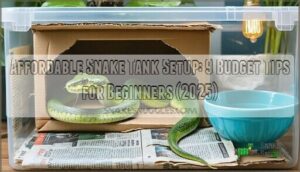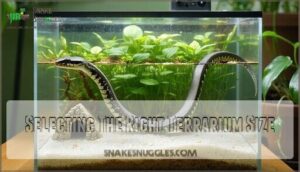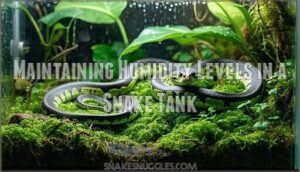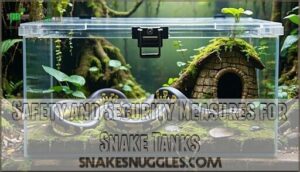This site is supported by our readers. We may earn a commission, at no cost to you, if you purchase through links.

Use simple newspaper or kraft paper as substrate, which is cheap and easy to replace. An under-tank heater provides necessary warmth without fancy equipment.
Create hiding spots using cardboard boxes or plastic containers you already have. Skip the costly decorations initially and focus on essentials: proper temperature, secure lid, and water bowl.
Think of it as building a cozy studio apartment rather than a mansion. Smart shopping and DIY creativity can slash your setup costs substantially.
Table Of Contents
- Key Takeaways
- Choosing a Snake for Beginners
- Affordable Snake Tank Setup Cost
- Essential Components for a Snake Tank
- Setting Up a Snake Tank on a Budget
- Maintaining Humidity Levels in a Snake Tank
- Providing Enrichment for Your Snake
- Safety and Security Measures for Snake Tanks
- Ongoing Care and Maintenance for Your Snake Tank
- Upgrading and Maintenance for Growing Snakes
- Frequently Asked Questions (FAQs)
- How do I set up a snake tank?
- How do I choose the right snake tank size?
- What is the best tank for a corn snake?
- How to design a snake tank?
- What do you put in a snake tank?
- How do I choose a snake terrarium?
- What 5 basic things are needed to house a reptile?
- What not to put in a snake tank?
- What goes in the bottom of a snake tank?
- How much does it cost to set up a snake enclosure?
- Conclusion
Key Takeaways
- You can slash setup costs by using plastic storage tubs instead of glass terrariums, newspaper for substrate, and DIY hiding spots from cardboard boxes or household containers.
- You’ll need to prioritize four essential components first: a secure escape-proof enclosure, reliable heating with thermostat control, two hiding spots, and a heavy water bowl that won’t tip.
- You should choose beginner-friendly snakes like Spotted Pythons or Children’s Pythons that stay around 3-4 feet long, have gentle temperaments, and don’t require expensive specialized setups.
- You can expect to spend $200-500 for a complete basic setup, with smart shopping for used equipment and bulk substrate purchases helping you stay on the lower end of that range.
Choosing a Snake for Beginners
Picking your first snake isn’t like choosing a goldfish—you’ll want a species that won’t turn your budget into snake food or give you stress-induced gray hair.
Your wallet will thank you for choosing a snake that doesn’t eat money faster than mice.
Spotted Pythons and Children’s Pythons top the beginner list because they stay manageable at around 3 feet long, have gentle temperaments, and won’t demand fancy setups that cost more than your car payment.
Spotted Pythons Characteristics
Think of Spotted Pythons as the perfect starter snake – they’re like training wheels for reptile enthusiasts.
Their gentle nature and manageable size make them ideal for beginners, as they max out at 100cm, making size limitations manageable for any terrarium.
Their calm temperament specifics shine during handling, rarely showing aggression.
You’ll appreciate their feeding habits – they’re not picky eaters.
With proper snake habitat setup, your Spotted Python thrives in modest enclosure needs, perfect for beginners.
Children’s Pythons Characteristics
Children’s Pythons steal hearts with their stunning iridescent sheen that catches light like living jewelry.
These beginner snake champions combine beauty with practicality, making them perfect for new reptile parents. Their gentle nature shines through every interaction, creating confidence for nervous gentle handlers.
- Adult size stays manageable at around 3-4 feet, fitting standard terrarium size requirements
- Iridescent sheen creates rainbow reflections that never get old
- Gentle nature makes handling sessions stress-free for beginners
- Captive care requirements are forgiving and straightforward
- Childrens Python temperament suits first-time snake breeds enthusiasts perfectly
Other Beginner-Friendly Snake Breeds
Looking beyond Children’s Pythons, several beginner-friendly snakes won’t empty your wallet.
Corn Snakes top most lists—they’re docile, colorful, and practically foolproof.
King Snakes handle well but need secure lids since they’re escape artists.
Rosy Boas stay small and eat less frequently, making them budget-friendly.
Garter Snakes and Milk Snakes round out the starter pack with gentle temperaments and straightforward care requirements for your affordable snake tank setup.
Affordable Snake Tank Setup Cost
You’re probably wondering how much cash you’ll need to set up a proper snake home without breaking the bank.
The good news is that a basic tank setup typically costs between $200 to $500, and there are plenty of smart ways to cut those expenses while keeping your scaly friend happy and healthy.
Initial Investment and Ongoing Expenses
Setting up your first snake tank involves two financial phases that’ll impact your wallet differently. Initial Costs for a basic setup range from $200-500, covering your enclosure, heating equipment, and snake tank essentials.
However, don’t forget about Recurring Expenses that keep your slithery friend happy long-term.
Smart Budgeting Tips help stretch every dollar:
- Buy quality heating equipment once instead of cheap replacements
- Purchase substrate in bulk for Long-Term Savings
- Start with essential items, add decorations gradually
- Consider used glass tanks from online marketplaces
- DIY decorations using safe household materials
Value Justification comes through proper planning.
Tips for Reducing Setup Costs
Smart shopping starts with hunting for used equipment at reptile expos and Facebook groups.
You’ll find quality tanks for half the price. DIY enclosures work great using plastic tubs with proper ventilation.
Buy bulk substrate to slash ongoing costs, and connect with local breeders for affordable supplies.
Your budget reptile habitat doesn’t need fancy decorations – simple inexpensive snake setup options work perfectly for happy, healthy pets.
Prioritizing Essential Components
Your affordable snake tank setup needs these four essential components first, like building a house foundation before adding fancy trim.
Tank Essentials include secure enclosures with proper ventilation, reliable heating solutions, and constant water access. You’ll need quality heating equipment, appropriate snake substrate, and humidity control too.
- A escape-proof tank with locked lid
- Under-tank heater with thermostat control
- Two hiding spots for security
- Heavy water bowl that won’t tip
Essential Components for a Snake Tank
You’ll need several key items to create a safe, comfortable home for your snake, and getting the basics right doesn’t have to break your budget.
The three most important components are a properly sized terrarium, suitable substrate for the floor, and a reliable heating system to keep your scaly friend happy and healthy.
Selecting The Right Terrarium Size
Getting your terrarium size right from the get-go saves you headaches and cash down the road.
Your snake’s comfort depends on proper tank dimensions that match their current snake size and future growth.
Think of it like buying shoes – too tight causes stress, too roomy feels overwhelming.
Here’s your sizing roadmap:
- Length: Tank should equal your snake’s full length for stretching
- Width: Half the snake length gives adequate movement space
- Height: Consider arboreal needs for climbing species
A 20-gallon tank works perfectly for most beginners with young pythons or corn snakes.
Pay attention to ventilation importance – proper airflow prevents mold while keeping your pet secure.
Plan upgrade timing as your snake grows to avoid cramped conditions.
Choosing The Best Substrate for Snakes
Your snake’s substrate is like the foundation of a house – get it wrong, and everything else suffers.
Aspen shavings top the budget-friendly list, offering excellent burrowing needs support while staying dust-free.
Freeze them overnight to eliminate potential pests before use.
Many owners find suitable aspen options for their snakes.
Coconut husk excels at humidity control but costs more upfront.
It’s worth the investment for species requiring higher moisture levels.
Cypress mulch strikes a perfect balance, providing decent shedding aid while maintaining moderate humidity.
When doing a cost comparison, newspaper mixed with chemical-free soil works as a DIY option, though it requires more frequent changes.
Avoid cedar or pine – substrate toxicity from aromatic oils can harm your snake’s respiratory system.
Layer any substrate at least 3 inches thick for natural behavior.
Heating and Lighting Options for Snakes
Your heating equipment creates a cozy environment that keeps your snake healthy and happy.
Heat mats under one-third of the tank provide ground warmth, while basking lamps offer natural overhead heat.
Ceramic heaters maintain consistent temperatures without light.
Thermostat control prevents dangerous overheating and guarantees heat mat safety.
UVB lighting supports natural behaviors, and proper snake lighting with heat lamp timers creates essential day-night cycles for peak health.
Many owners buy reptile heating products online.
Setting Up a Snake Tank on a Budget
You don’t need to break the bank to create a comfortable home for your scaly friend, since smart shopping and creative solutions can cut your setup costs in half.
With the right approach, you’ll build a safe, functional habitat that keeps both your snake happy and your wallet intact.
DIY Decorations and Enrichment Ideas
Creating DIY decorations doesn’t require expensive store-bought items.
Transform cardboard tubes into climbing branches or repurpose PVC pipes as enrichment items. Sanitized backyard branches make natural perches, while hollow logs create cozy hideaways.
Cork tile backgrounds and pillow moss are budget-friendly additions. Always choose safe materials that you can disinfect easily.
These DIY decor projects provide plant enrichment alternatives while keeping costs low.
Affordable Hiding Places and Visual Barriers
Smart repurposing transforms everyday items into perfect DIY hides and budget barriers for your snake’s comfort.
These creative enrichment solutions cost pennies compared to pet store alternatives while providing essential natural coverage your snake craves.
Here are affordable hiding spots that’ll make your snake feel secure:
- Cleaned cardboard boxes with multiple entry points
- PVC pipes cut to appropriate lengths
- Repurposed plastic containers with smooth edges
- Empty paper towel rolls for juveniles
- Sanitized ceramic flower pots on their side
Creating a Naturalistic Environment
Beyond basic hides, you can transform your snake’s space into a mini wilderness.
Naturalistic Substrates like coconut fiber mixed with leaf litter create authentic textures.
Sanitized backyard branches provide Climbing Enrichment, while smooth rocks add visual appeal.
Hardy plants offer Plant Integration benefits—pothos thrives in terrariums.
These natural elements and DIY decor choices give your snake Hides and Security while creating stunning landscaping that won’t break your budget.
Choosing The Right Heat Source
After setting up your snake’s natural environment, you’ll need reliable heating equipment that won’t drain your wallet.
Smart heat source selection keeps your snake healthy without breaking your budget.
Here are three budget-friendly heating options:
- Heat mats provide consistent warmth with excellent heat mat safety features and low electricity costs
- Ceramic heat emitters (CHEs) offer CHE benefits like 24/7 operation and long lifespan
- Basic thermostats guarantee thermostat importance for temperature control while staying affordable
Consider snake heat mat options for efficient heating.
Remember: proper gradient creation matters more than expensive gear.
Installing Proper Lighting Systems
Your snake’s lighting setup doesn’t need to cost a fortune.
Mount UVB lighting securely above the enclosure using ceramic sockets rated for your bulb’s wattage. Position basking lamps at a 45-degree angle for ideal coverage, and consider budget-friendly LED options for ambient lighting.
Wire guards prevent accidents and overheating. UVB Benefits include better calcium absorption and natural behavior.
Skip expensive night lighting – your snake prefers darkness after sunset. Proper ventilation around fixtures keeps everything running safely and efficiently.
Creating a Day-Night Cycle
Your lighting setup needs a day-night cycle to keep your snake’s circadian rhythm on track.
A $10 timer system automatically controls LED lighting and UVB lighting for 12-hour light schedules.
This creates natural temperature drops at night, mimicking seasonal changes.
The behavioral impact is huge – consistent day-night patterns help your snake eat, shed, and stay healthy year-round.
Maintaining Humidity Levels in a Snake Tank
Your snake’s humidity needs are like a Goldilocks situation – not too dry, not too wet, but just right for healthy shedding and breathing.
You’ll need to monitor levels with a hygrometer and use simple tricks like misting bottles or humidity-friendly substrates to keep your scaly friend comfortable without breaking the bank, ensuring a perfect environment for healthy shedding.
Incorporating Misting Systems
Proper humidity control doesn’t have to break the bank when you choose the right misting system types. Spray bottles ($5-10) offer budget-friendly humidity automation through daily manual misting, while automated systems ($30-100) handle the work for you.
Focus on strategic nozzle placement near your snake’s hide areas for maximum effectiveness. Use distilled water quality to prevent mineral buildup on glass surfaces.
Establish consistent maintenance schedules by misting 1-2 times daily, especially during evening hours when natural humidity peaks occur.
Using Humidity-Retaining Substrates
Your substrate selection becomes the foundation of perfect substrate moisture levels in your snake’s home.
Cypress mulch and coco fiber naturally hold humidity while preventing costly mold issues.
- Different species substrate needs vary—ball pythons love cypress mulch’s moisture retention
- Burrowing benefits make coco fiber perfect for sand boas and kenyan sand boas
- Cost comparison shows these substrates outlast cheaper alternatives by months
Monitoring Humidity Levels
Your humidity-retaining substrate‘s working hard, but you’ll need to track its performance like a hawk. A digital hygrometer becomes your humidity detective, giving you the real story about what’s happening inside your snake’s home.
Think of humidity control as your snake’s comfort barometer – too dry and your pet struggles with shedding, too wet and you’re inviting mold problems. Smart hygrometer placement and consistent monitoring keep everything balanced.
- Position hygrometers at both warm and cool ends for accurate readings
- Check humidity levels twice daily during morning and evening routines
- Adjust misting frequency based on seasonal changes and substrate moisture
- Maintain shedding humidity between 50-60% for most beginner snake species
- Consider DIY humidifiers like water bowls on heat sources for budget solutions
Providing Enrichment for Your Snake
Your snake won’t ask for a TV remote or video games, but it still needs mental stimulation to stay healthy and happy in its tank.
You can create interesting spaces using affordable items like cardboard tubes, sanitized branches from your yard, and even PVC pipes that double as climbing structures and hiding spots.
Adding Decorations and Enrichment
Your snake’s tank doesn’t need expensive decorations to create an engaging home.
Climbing branches from your backyard work perfectly after sanitizing – just verify they’re from safe materials like oak or maple. DIY hides using clean plastic containers cost pennies compared to store-bought options.
Add fake plants and cork bark to create visual barriers that boost confidence.
These enrichment items provide mental stimulation while DIY decorations keep costs low.
Strategic placement of tank decorations transforms a basic setup into an enrichment-rich environment your snake will love exploring.
Incorporating Live Plants
Live plants transform your snake tank setup from ordinary to outstanding without breaking the bank.
Choose hardy options like pothos or snake plants that’ll survive your serpent’s curiosity. Always check for Plant Toxicity before adding anything – even non-herbivorous snakes can accidentally ingest leaves.
Consider their Lighting Needs and Soil Choice carefully, avoiding pesticide-treated options from big-box stores. Smart Plant Placement prevents uprooting, while proper Watering Methods maintain humidity naturally.
Unlike fake plants that gather dust, live greenery helps create a natural habitat that’s both affordable and beneficial for your scaly friend.
Safety and Security Measures for Snake Tanks
You’ll need escape-proof lids with sturdy locks, sealed gaps, and secure entry systems to keep your snake safely inside its tank where it belongs.
A loose snake becomes an expensive game of hide-and-seek that your neighbors won’t appreciate, so investing in proper security measures protects both your pet and your peace of mind.
Installing Escape-Proof Lids and Locks
Your snake’s happiness means nothing if they vanish overnight like a magician’s assistant. Secure the tank with sturdy lid materials and reliable locking mechanisms – snakes are surprisingly strong escape artists who’ll exploit any weakness.
Escapeproof lids with clamp-style locks or sliding mechanisms create tight seals that prevent accidental openings. Add multiple locking points around the enclosure for extra security.
DIY solutions like repurposed cabinet locks work perfectly on tight budgets. Regular security checks guarantee your preventing escapes system stays foolproof.
Sealing Potential Escape Routes
After you’ve got your escape-proof lids locked down tight, it’s time to hunt for those sneaky gaps that turn your tank into a reptilian Houdini act.
Even the smallest opening becomes a highway to freedom for your slithery friend.
Your detective work should focus on these common escape routes:
- Seal ventilation gaps with fine mesh screening to maintain airflow while blocking exits
- Cover cable entry points with silicone sealant around power cords and equipment
- Fill gaps between tank panels using aquarium-safe caulk
- Secure decorations that might create hidden tunnels or loose spots
- Check fixture mounts for gaps where hardware meets glass
Remember, snakes are master escape artists who’ll exploit any weakness. Take your time inspecting every corner, joint, and connection point to secure the tank properly.
Implementing Double-Door Entry Systems
After sealing gaps, you’ll want enhanced security through double-door entry systems.
These setups prevent escapes during maintenance access and feeding safety routines. You can merge two enclosures by cutting holes, buy replacement doors from companies like Animal Plastics, or use conversion kits for 10-gallon tanks.
Install runner boards to contain substrate. Vivarium locks make doors stay shut, making your affordable snake tank setup truly escape-proof.
Entry System Type Security Level DIY Difficulty Best For
Ongoing Care and Maintenance for Your Snake Tank
Once you’ve got your snake tank set up, you’ll need to keep it clean and check temperatures regularly to keep your scaly friend happy and healthy.
Think of it like doing light housework – except your roommate won’t complain if you miss a spot, and the reward is watching your snake thrive in their cozy home.
Cleaning The Enclosure
Keeping your snake’s home spotless doesn’t require expensive products or complicated routines. Think of cleaning like maintaining your own bedroom – regular tidying prevents bigger headaches later.
Daily waste removal and weekly substrate changes using reptile-safe disinfectant prevent bacteria and parasites from taking hold.
Here’s your cleaning and maintenance schedule:
- Daily: Remove waste and uneaten food immediately
- Weekly: Spot-clean soiled substrate and sanitize water bowl
- Monthly: Deep-clean with approved disinfecting methods
- Quarterly: Complete substrate changes and equipment inspection
Schedule adherence: Consistent water sanitation prevents illness outbreaks
Monitoring Temperature and Humidity
Now that your tank’s squeaky clean, your hygrometer and thermostat become your best friends.
Check temperature and humidity twice daily – morning and evening work great.
Place your hygrometer away from your heat source to get accurate readings.
Thermostat calibration monthly keeps things precise.
Seasonal adjustments matter too; winter air gets drier, so tweak your humidity control accordingly.
Rotating Decorations and Enrichment
Beyond tracking temperature and humidity, your snake’s home needs regular makeovers to prevent the reptile equivalent of cabin fever. Environmental enrichment keeps your pet mentally sharp and physically active through sensory stimulation.
Rotate these elements every few weeks for ideal cognitive stimulation:
- Swap hiding spots with different textures like cork bark or PVC pipes
- Rearrange climbing branches to create fresh exploration routes
- Add puzzle feeders or textured surfaces for behavioral diversity
This environmental complexity mimics nature’s ever-changing landscape.
Upgrading and Maintenance for Growing Snakes
Your snake won’t stay tiny forever, and that cute 20-gallon tank will feel like a studio apartment to a growing python.
You’ll need to upgrade your setup as your snake matures, adjusting everything from tank size to heating systems to keep your scaly friend comfortable and healthy.
Assessing Space Requirements as Snakes Mature
Your snake won’t stay pocket-sized forever, and cramped quarters stress out growing reptiles.
Monitor your pet’s Growth and Space needs monthly to determine Tank Upgrade Timing. Adult Size Matters when planning your snake tank setup – a baby corn snake‘s 10-gallon terrarium becomes inadequate once it hits three feet.
| Life Stage | Typical Length | Minimum Enclosure Size |
|---|---|---|
| Hatchling | 8-12 inches | 10 gallons |
| Juvenile | 18-30 inches | 20-30 gallons |
| Adult | 3-6 feet | 40+ gallons |
| Large Adult | 6+ feet | 75+ gallons |
Snake Stature Impact affects Behavioral Space Needs substantially – longer snakes require proportionally larger tank size to exhibit natural behaviors comfortably.
Adapting Heating and Lighting for Larger Enclosures
When your snake outgrows their current home, larger enclosure heat becomes trickier to manage.
You’ll need higher lighting wattage and smarter thermostat placement to maintain proper thermal gradient.
Adjust basking distance accordingly – too close burns, too far chills.
Heat lamp placement directly affects gradient maintenance, so position your heat source carefully.
Test your temperature gradient with multiple thermometers before moving your snake in.
Incorporating More Complex Enrichment Features
As your snake grows up and out, it’s time to level up the fun factor with enrichment items that challenge both body and mind.
Here are three budget-friendly ways to create climbing complexity:
- DIY Decor Networks: Connect climbing branches with hiding spots using PVC pipes for foraging puzzles
- Interactive Feeding Stations: Rotate enrichment weekly for sensory stimulation
- Environmental Rotation: Switch decorations monthly to maintain curiosity
Frequently Asked Questions (FAQs)
How do I set up a snake tank?
Building your snake’s home is like creating a cozy studio apartment.
You’ll need proper heating, two hiding spots, fresh water, and suitable substrate.
Match tank size to your snake’s length for comfort.
How do I choose the right snake tank size?
Pick a tank that’s at least as long as your snake will grow, plus half that length for width.
Your pet needs room to stretch out fully without feeling cramped or stressed.
What is the best tank for a corn snake?
Here’s your corn snake’s perfect home: a 40-gallon long tank works brilliantly for adults.
You’ll want glass or PVC with secure locks, proper ventilation, and enough length for stretching—they’re escape artists who love space!
How to design a snake tank?
Start by choosing a tank that’s as long as your snake, with secure lids and proper ventilation.
Add heating on one side, hiding spots on both ends, water bowl, and substrate for comfortable living, ensuring proper ventilation.
What do you put in a snake tank?
Think of your snake’s home like a cozy apartment.
You’ll need substrate flooring, two hiding spots, a sturdy water bowl, heating elements, climbing branches, and secure decorations to create their perfect sanctuary.
How do I choose a snake terrarium?
Choose a terrarium that’s at least as long as your snake’s full body length.
You’ll need secure lids, proper ventilation, and room for temperature gradients.
Glass or PVC work best for most species.
What 5 basic things are needed to house a reptile?
You’ll need a secure enclosure with proper ventilation.
A reliable heating system with thermostat.
Hiding spots on both warm and cool sides.
Fresh water bowl.
And appropriate substrate for your reptile’s comfort.
What not to put in a snake tank?
Cedar shavings are toxic to snakes, so skip those completely.
Don’t use small decorations your snake could swallow, sharp objects that might cause injury, or anything that traps moisture and grows dangerous mold.
What goes in the bottom of a snake tank?
Substrate forms your snake’s foundation.
Aspen shavings work great for most species, while cypress mulch suits humidity-loving snakes.
Avoid cedar—it’s toxic.
You’ll want something that’s easy to clean and holds moisture appropriately.
How much does it cost to set up a snake enclosure?
Setting up your first snake home won’t break the bank. You’re looking at $200-500 for a basic setup including tank, heating, substrate, and essentials. Budget-friendly choices can slash costs substantially.
Conclusion
While expensive glass terrariums might catch your eye, your wallet will thank you for choosing practical alternatives.
Building an affordable snake tank setup doesn’t mean cutting corners on your pet’s health and happiness. You’ve learned that plastic tubs, newspaper substrate, and DIY hiding spots work just as well as costly equipment.
Start small, focus on essentials like proper heating and security, then upgrade gradually. Your snake won’t know the difference, but your bank account certainly will, which is a significant factor in maintaining a practical approach to pet care.
- https://www.homedepot.com/b/Plumbing-Pipe-Fittings-Pipe-PVC-Pipe/N-5yc1vZ1z18i41
- https://www.thespruce.com/spider-plants-chlorophytum-definition-1902773
- https://www.nrel.gov/docs/fy14osti/61040.pdf
- https://onlinelibrary.wiley.com/doi/abs/10.1002/jez.521
- https://avmajournals.avma.org/doi/abs/10.2460/ajvr.69.2.294





















